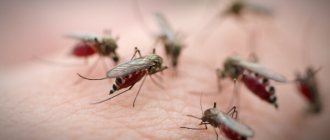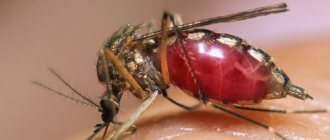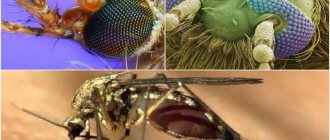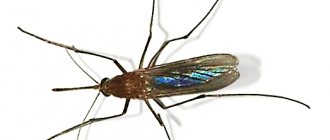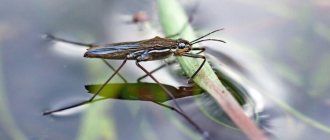Bed bugs are a problem that almost every person faces at least once in their life. In order to understand how to get rid of bedbugs in an apartment, it is advisable to understand how they reproduce and at what speed they spread throughout the home. Understanding that bedbugs lay eggs protected by a dense shell will help you choose the right insecticide that will kill not only the adults, but also the eggs.
In this article we will figure out how bed bugs reproduce, how many larvae a female can hatch in her life, and whether one bed bug that gets into an apartment can reproduce.
Stages of bedbug development, life cycle
In life, any bug goes through several stages of development. Moreover, an individual can die at any stage. For further development, bedbugs need blood, without which they will not be able to move to another stage. The entire development period lasts about 1 month, but the duration may also depend on various factors:
- Temperature conditions. For better life, a temperature of about 20-25 degrees is suitable.
- Humidity. Everyone knows that insects love moisture, and bedbugs are no exception.
- Darkness. Bedbugs live only in dark places, that is, if there is not a single dark corner in the house, then bedbugs will not be able to reproduce and exist there.
- Nutrition. To reproduce and grow, bedbugs need human blood. Without it, the population will most likely cease to exist.
In total, there are 7 stages in the development of a bug, which occur sequentially one after another. Egg. It has just been laid by the female. The eggs reach 1mm, they are translucent and oval.
- 1st stage of larvae. The larva has just hatched from the egg and started living. Reaches 1.5mm in length. The body is white, almost transparent.
- 2nd stage of larvae. The bug is already growing - 2mm in length, the body is gradually becoming darker. Such larvae are sometimes called nymphs. They are not yet capable of reproduction.
- 3rd stage of larvae - 2.5 mm. At this stage, the larva begins to actively shed hair, due to the absence of a chitinous membrane on the skin. The individual is still unable to reproduce
- 4th stage of larvae - 3mm. At this stage, the larva has its first feeding, as the body needs it for complete molting. Nymphs consume too much blood and cause inconvenience to humans, since there are 20 times more larvae per 1 adult. Small bugs do not inject anesthetic into the blood, so their bites are especially painful.
- 5th stage of larvae - 4.5mm. There is evidence that even at this stage individuals can reproduce, but not all attempts to lay eggs are successful.
An adult insect is 5 - 5.5 mm in length, such an individual is ready for reproduction.
How to prevent reproduction
If parasites appear in the house, they will multiply and infect neighboring apartments. Therefore, along with the destruction of sexually mature individuals, it is important to prevent their reproduction.
If at least one bedbug is detected, the room must be treated immediately.
Given the survivability of this species, insecticides (preparations for killing insects) that are effective for 1-3 months should be selected.
Regular ventilation and bright lighting will help get rid of parasites.
Additionally, you can quartz all rooms with a special lamp. Cold, lack of moisture and food slow down the development and growth of domestic parasites. During the second week without food, their reproduction process stops.
Bedbugs do not tolerate temperature changes, heat and frost well. If you raise the temperature in the apartment to 45°C for 1 hour or lower it to 17°C for a day, the bloodsuckers will die. You can take the furniture outside in hot weather or in extreme cold.
In urban environments, this option is often not available, so an alternative option is to treat all places where parasites can nest with a steam generator, pack the bedding in sealed bags and leave it in the freezer for a day.
It is advisable to get rid of unnecessary things and old furniture - they can serve as a refuge for parasites and a nest for breeding offspring.
Where to look for larvae
Bloodsuckers prefer to be closer to a food source, so most often they nest near a sleeping place.
Habitats of bedbugs in the house.
First, you need to examine for the presence of larvae:
- Bed linen, mattress seams, gaps between the joints of upholstered furniture, a drawer for bed linen.
- Cracks in bed frames.
- Gaps in baseboards.
- Joints of loose wallpaper.
- The inside of the carpets.
- Sockets, switches, household appliances.
- The floor is under linoleum where possible.
Nests can also be located under furniture; this can be discovered when sweeping the floor. The main guideline in the search is the waste products of bedbugs: empty capsules of larvae, excrement and chitinous shells left after molting.
The specific smell that comes from bedbugs also makes the search easier.
How do bedbugs reproduce?
Bedbugs reproduce like most insects - through mating. Moreover, unlike other insects, sexual contact does not occur by mutual desire. The male forcibly inserts his sexual organ into the cavity of the female, piercing her and injecting seminal fluid. Bed bugs reproduce through trauma. The seed enters the female's abdominal cavity and is stored there all her life, thanks to which the female can independently fertilize and breed new offspring without the help of a male.
Female bedbugs mate only once in their entire lives. And they produce offspring (lay eggs) for the entire remaining time.
Moreover, from one such sexual contact a whole family of bedbugs can appear in one apartment. Some time after fertilization, the female begins to lay 5-15 eggs per day. It is important to note that males are not very picky in choosing a sexual partner, and often attack individuals of the same sex, or small females. It should be noted that according to research results, males with a pierced belly are very often found in the population.
How bed bugs reproduce: video
Sources:
- “Traumatic insemination and sexual conflict in the bed bug Cimex lectularius,” Alastair D. Stutt and Michael T. Siva-Jothy // PNAS May 8, 2001. 98 (10) 5683-5687
- “Nymphs of the common bed bug (Cimex lectularius) produce anti-aphrodisiac defense against conspecific males,” Vincent HarracaCamilla RyneRickard Ignell // BMC Biology, December 2010, 8:121
- “Immune System Protects Female Bedbugs From Traumatic Sex,” Elizabeth Pennisi // Science, Aug. 22, 2011
- “Inbreeding Reason for Bedbug Spread, Study Says” // Fox News Health, December 07, 2011
- “Genetic Analysis of Bed Bug Populations Reveals Small Propagule Size Within Individual Infestations but High Genetic Diversity Across Infestations From the Eastern United States” // Journal of Medical Entomology 49(4): 865Ð875 (2012);
Please rate the material
Where in the apartment do bedbugs make a nest?
Most often, bedbugs strive to prevent people from discovering them, so they hide in all the dark crevices where it can be convenient. They are called bedding because they mainly live in mattresses, beds and under them, as well as in bedding.
These insects do not care about their habitat, the main thing is that there is a comfortable temperature, sufficient humidity, close food and darkness.
It is difficult to detect bedbugs during daylight hours because they are carefully hidden. The period when a bedbug is active when it can be detected is during a person’s deep sleep, which occurs early in the morning. Usually at this time people wake up from larval bites, which feel quite painful. At the same time, they live in nests, and can also reproduce in clothes.
The nest is in chaos, there is absolutely no hierarchy in it. In the “house” of bedbugs, larvae can be mixed with adults and waste products. Moreover, there may not even be one, but several nests of bedbugs in the apartment. In this case, individual larvae separate from the population and form their own families.
How quickly do bedbugs reproduce?
In order to understand how quickly bedbugs reproduce, you need to calculate how many eggs the females lay. Usually this is from 30 to 60 individuals per month. But you need to take into account that during this time the female will breed new females, that is, the reproduction process will occur in geometric progression. In this case, bedbugs reproduce through traumatic insemination, the mechanism of which is described above. At the same time, a female can lay no more than 700 eggs in her entire life, and she lives for about a year. During this time, the apartment can turn into “hell,” especially if a lot of people live in the apartment, since human blood is food for parasites.
Can one bug reproduce?
For a long time they could not find a definite answer to this question, since they had previously conducted experiments by placing one female in a box and she began to lay eggs after some time. Now time has passed and the mechanism of reproduction of these insects has been fully studied. One bug can only reproduce if it is a female and she has already been fertilized.
Males themselves cannot reproduce, this was discovered scientifically through a series of experiments. Moreover, populations in which there were only males, although they made attempts to reproduce, it was not possible. In this regard, bedbugs are not able to reproduce alone.
Can bedbugs reproduce without food?
In order for fertilization to occur in bedbugs, both males and females need blood, otherwise their body simply will not have a sufficient reserve. Moreover, for this process there should be about 3-7 full meals (blood). Individuals feed only at night, for fear of being discovered. Bedbugs cannot exist without blood.
Moreover, bedbugs need blood not only for reproduction, but also for growth. At different stages of the life cycle, the amount of blood consumed by individuals is different. For example, bedbug larvae consume less food, but more often, while adult bedbugs drink more blood at a time, but do it much less frequently.
When bedbugs starve, their body begins to dry out, and all vital processes slow down. They become passive, practically do not move and spend all their time in the nest.
What prevents reproduction
Females and males reproduce quickly only in a comfortable environment. When unfavorable conditions arise, insects slow down the rate of population increase.
Temperature
The optimal temperature for the development and life of an insect is +25…+30°C. Until the ambient temperature drops to +10°C, bedbugs will continue to reproduce, but at a slower rate.
This process stops completely when suspended animation occurs, i.e. when the ambient temperature drops to +5°C and below. Frost from -10°C is fatal for bed bugs.
Humidity
Bed bugs feel most comfortable in warm and dry rooms. Parasites cannot tolerate high humidity; the optimal indicators for them are 40-60%. Low humidity is easily tolerated by adult insects; they replenish the lack of fluid by increasing the amount of blood they consume.
The eggs run the risk of dying, because if there is a lack of environmental humidity, they quickly dry out and the embryo dies. If the humidity is too high (70% or higher), the eggs are susceptible to fungal infections.
Lack of food
A bedbug can live without blood for 3-4 days, a larva - 2-3 days. But even a month of hunger strike does not lead to the death of the bed parasite. If the insect does not receive food within 14-16 days, it will fall into a “inhibited” state - suspended animation. In this state, all processes in the body slow down, and nutrient consumption is reduced to a minimum.
Important! With the lack of food, the ability to reproduce offspring stops.
Anabiosis
Anabiosis is the next stage of “slowing down” the life activity of the bug. This state occurs at a temperature of 0…+5°C. Too high a temperature does not lead to suspended animation, it kills the insect. The larva dies at +45°C, the adult bug lasts up to +70°C.
In this state, the parasite stops moving, feeding and reproducing.
Can a bug reproduce alone?
The bedbug is not a hermaphrodite, so the insect must mate to procreate. The female is inseminated once in her life, and begins to lay eggs daily. If there is one fertilized female in the room, there is normal humidity, plenty of food and an acceptable temperature, then after 2-3 months the number of insects will increase significantly.
If one male bug appears, it will not reproduce.
Bed bugs reproduce quickly but are highly dependent on environmental conditions. Cold indoors (below +5°C) puts the insect in a state of suspended animation, which stops the reproduction process. High or low air humidity (above 70% and below 30%) destroys eggs. Also, the reproduction process stops when there is a lack of food for more than 2 weeks. All these features are often used in the fight against bed bugs, for example, by freezing the room.

